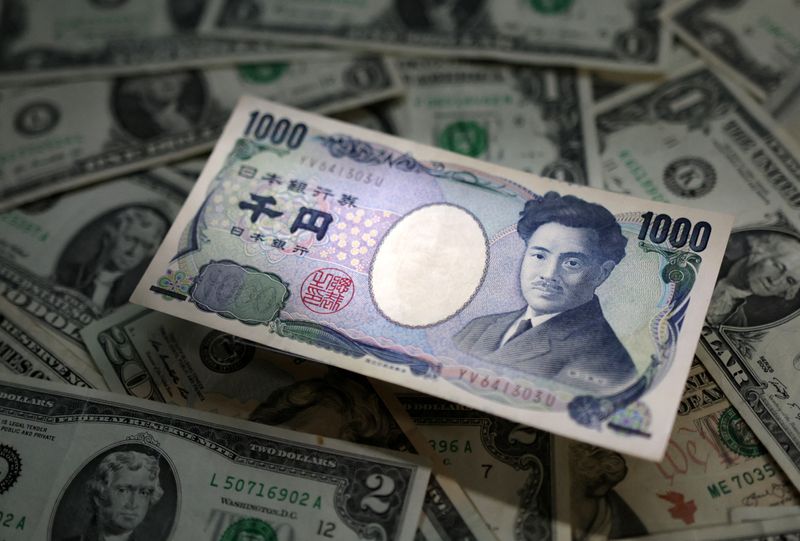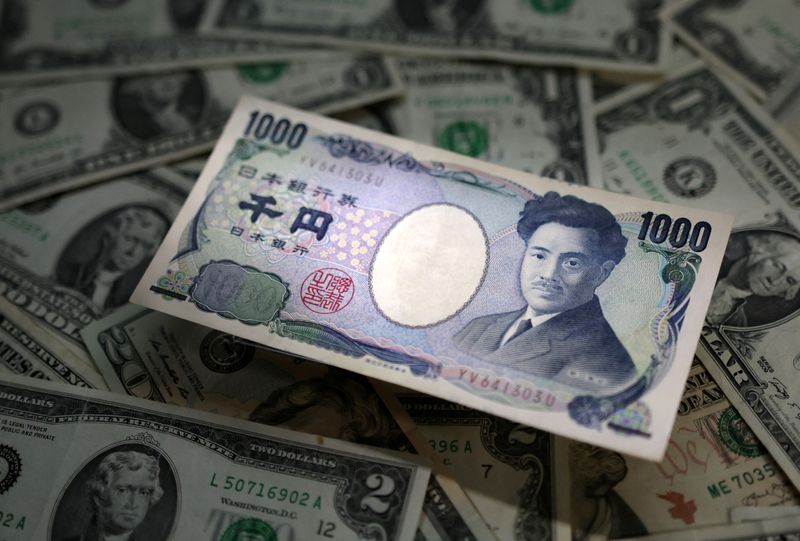
By Rae Wee and Sruthi Shankar
SINGAPORE (Reuters) -The yen hit its strongest in over four months on Wednesday, as Bank of Japan (BOJ) Governor Kazuo Ueda flagged the possibility of more rate hikes after the central bank raised interest rates and unveiled a plan to taper its huge bond-buying programme.
The yen strengthened by as much as 1.8%, pushing the dollar to an intraday low of 150.05, the Japanese currency’s strongest level since March.
Ueda left the door open to further rate hikes this year, saying the central bank did not see the 0.5% level “as any key barrier” when raising rates.
“There is a sense that this isn’t a one-off panicky move, there’s more to come down the pipe,” Kit Juckes, head of FX strategy at Societe Generale (OTC:SCGLY), said.
“The markets were already confident that they were going to get a rate hike this month or next month, but it is pricing in the probability of more after that with greater confidence,” he said.
Earlier on Wednesday, BOJ raised its overnight call rate target to 0.25%, from 0-0.1%, following a two-day monetary policy meeting and announced it would roughly halve monthly bond-buying to 3 trillion yen ($19.88 billion) as of January-March 2026.
Analysts said Wednesday’s rate hike had been well telegraphed thanks to various news reports, but still defied the market consensus. The BOJ’s tapering plan, meanwhile, came in more modest than expected.
The yen looked set to end July with a gain of more than 6%, its biggest monthly rise since its 7.2% rally in November 2022, – helped by Tokyo’s bouts of intervention and the unwinding of short-yen carry trades prior to the BOJ decision.
The month-end marked a busy day for investors given a slew of data releases across major markets, with a policy decision from the U.S. Federal Reserve taking centre stage.
Data on Wednesday showed euro zone inflation unexpectedly edged up in July, while a widely watched gauge of price growth in the services sector eased.
The numbers might complicate the European Central Bank’s job, but did not derail existing market expectations for monetary policy. Futures markets currently show traders anticipate two more ECB rate cuts this year, in September and December.
At the same time, spreading geopolitical violence continued to cast a cloud.
The Australian dollar slid to its lowest since May after core inflation came lower than expected, greatly reducing the chances of another rate hike.
The Aussie was last down 0.6% at $0.6497, having fallen by as much as roughly 0.9% to a three-month low of $0.6480 after the Consumer Price Index data. That left the currency heading for a monthly loss of 2.5%.
Markets abandoned bets of a further rate hike from the Reserve Bank of Australia and now expect an easing as early as November. The RBA holds a policy meeting next week.
BRACING FOR THE FED
The euro edged up 0.2% to $1.0833, set for a roughly 1% gain in July, helped by a broadly weaker dollar.
The pound was flat at $1.28375 and was heading for a monthly gain of 1.5%.
Sterling options volatility exploded to its highest in almost a year, reflecting the degree of nervousness ahead of Thursday’s Bank of England rate decision where the chances of a cut are up in the air.
Traders were also awaiting the Fed’s rate decision, likely the next main catalyst for broad currency moves. Expectations are for the U.S. central bank to keep rates unchanged but lay the groundwork for a September rate cut.
The dollar index fell 0.3% to 104.12 and was set for a monthly loss of 1.5%.

“We expect (the Fed) to open the door to a first interest rate cut in September,” said Barclays Private Bank chief market strategist Julien Lafargue.
“With markets already pricing in slightly more than 25bp worth of cuts in September, the Fed may find it hard to push back against these expectations.” ($1 = 150.8900 yen)
This post is originally published on INVESTING.


